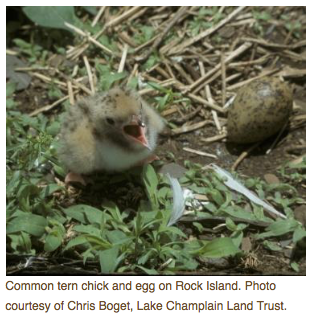Common Terns in Vermont: A Conservation Success Story
- Published: Monday, 06 June 2011 20:47
- Written by Laurel Neme
Protection of the breeding habitat of Vermont’s (uncommon) common tern has made it one of the state’s greatest conservation success stories.

Common terns are the most widespread tern in North America. Yet in many states, including Vermont, they’re threatened or endangered. In the early 1900’s, common terns, like other bird species, were almost extirpated by hunters for use on women’s hats. Because of their small size, whole common terns were often stuffed and placed on the top of hats. This, combined with the decimation of other bird species, led to several federal laws to protect these migratory birds – most notably the Migratory Bird Treaty Act of 1918, which prohibits the taking of birds, nests and eggs. Because of this protective legislation, common terns made a comeback in the 1920’s and 1930’s.
However, that changed has habitat loss continued to threaten the birds. As a result, common terns were forced to nest at marginal locations where the quality of their habitat was low and the risk of predation – from raccoons, skunks, opossums, gulls and even ants – is high. In Vermont’s Lake Champlain basin, for example, the number of common terns dropped from almost 400 nesting pairs in the 1960s to only 50 in 1988. Consequently, in 1989 the common tern was placed on the state of Vermont’s endangered species list.

The Lake Champlain Land Trust recognized that problem early on and, since 1978, worked to permanently conserve and protect several important common tern nesting islands in Lake Champlain. It started by reaching out to the landowners of the few islands with nesting common terns and educating them about the value of the birds and the problems they face. The Lake Champlain Land Trust then led the effort to purchase and protect the only possible island habitats for terns. Through the protection of breeding habitat, along with continual monitoring and management efforts of its partners at the Vermont Department of Fish and Wildlife, Green Mountain Audubon Society and Audubon Vermont, the story of the Common Tern is now one of Vermont’s greatest wildlife conservation victories. Their numbers have soared by over 300 percent, from just 50 breeding pairs at the end of the 1980’s to close to 200 today.
For more information, you can listen to Laurel’s “The WildLife” interview featuring Chris Boget, the Executive Director of the Lake Champlain Land Trust, talking about this conservation success story.
